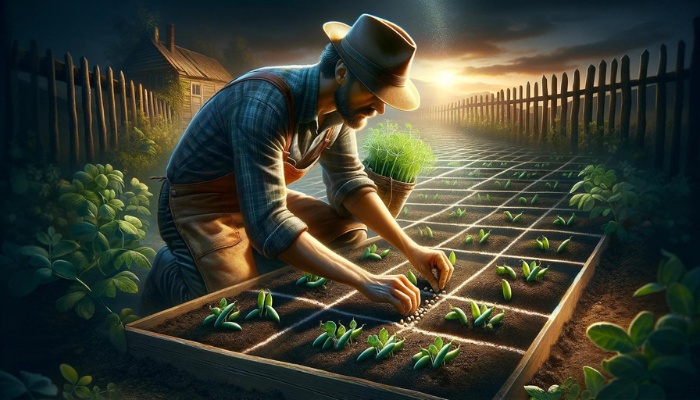Peas are an excellent choice for square foot gardening enthusiasts looking to maximize their yield in a minimal space.
Learn all the ins and outs of growing peas in a square foot garden, from selecting the right pea variety to planting, care, and harvesting.
Whether you’re a seasoned gardener or a green-thumbed novice, discover how you can elevate your gardening game and enjoy a bountiful pea harvest in your very own square foot garden.
Selecting the Right Varieties
Choosing the right varieties of peas is imperative for maximizing your yield in square foot gardening because each type possesses unique growth habits and environmental requirements.
You’ll need to consider both pea diseases and climate considerations when selecting the best varieties for your garden. Peas, being cool-season crops, thrive in temperatures between 55℉ and 65℉.
However, they’re susceptible to various diseases, such as powdery mildew and root rot, which can decimate your crop if you’re not careful.
To combat these issues, it’s wise to select disease-resistant varieties. These have been bred to withstand common pea diseases, ensuring a healthier crop.
Additionally, understanding your local climate is paramount. If you’re in a region with a short spring, opt for early-maturing varieties that can produce a harvest before the heat of summer stresses the plants.
Conversely, if cool weather lingers, mid-season or late-maturing varieties may provide a longer harvest period, giving you more bang for your buck.
Preparing Your Garden Bed
Before planting your pea seeds, it’s essential to properly prepare your garden bed to ensure optimal growth conditions. Start with testing your soil pH; peas thrive in a range between 6.0 and 7.0.
If your soil is too acidic or too alkaline, you’ll need to adjust it.
- For acidic soil, incorporate lime
- For alkaline soil, add sulfur
Adding well-rotted compost to your garden bed enriches the soil with essential nutrients, improving its structure and fostering a healthy environment for your peas to grow.
Ensure you’re mixing in the compost thoroughly, about a foot deep, as peas have deep roots that will benefit from the nutrient-rich soil.
Planting and Spacing Techniques

To ensure your peas thrive, it’s essential to master the planting and spacing techniques tailored to square foot gardening. This method maximizes yield in a limited space, promoting healthy growth and easy harvest. Here’s how to do it:
- Soil Preparation: Before planting, test your soil pH. Peas prefer a slightly acidic to neutral pH (6.0-7.0). Amend your soil accordingly to create the perfect environment for your peas to flourish.
- Spacing for Success: In square foot gardening, plant peas about 4 inches apart. This spacing allows for optimal air circulation and sunlight penetration, reducing the risk of disease and promoting robust growth.
- Companion Planting: Leverage companion planting to boost your peas’ health and yield. Plant peas near beneficial companions like carrots and radishes. These companions can help deter pests and optimize soil use, enhancing your peas’ growth without chemical interventions.
Care and Maintenance
Once your peas are planted, regular watering, monitoring for pests, and providing support for climbing varieties are key steps in ensuring a healthy and productive crop.
Watering frequency should be consistent to maintain moist but not waterlogged soil, which is critical for pea plants. Early morning is the ideal time to water to reduce evaporation and susceptibility to fungal diseases.
Pest control is essential for safeguarding your plants. Regular inspections help identify issues early, allowing for timely interventions. Biological and mechanical methods are preferred for maintaining an eco-friendly garden.
To aid in understanding, here’s a quick guide:
- Watering: Water deeply once a week; more if the weather is particularly hot or dry. Aim for at least 1 inch of water per week, including rainfall.
- Pest Control: Inspect leaves for signs of pest damage or disease. Use organic pesticides or introduce beneficial insects as a natural defense.
- Support Systems: For climbing varieties, ensure sturdy trellises or netting are in place to support growth and facilitate air circulation, reducing disease risk.
Harvesting and Enjoying
The harvest time directly impacts the sweetness and texture of peas. Typically, peas are ready for picking when they’re plump and bright green.
Gently support the vine with one hand while using the other to pick the pods to avoid damaging the plant.
Harvesting and enjoying peas from your square foot garden offers a rewarding experience that combines the joys of gardening with the pleasures of cooking and healthy eating.
Peas aren’t only delicious but also packed with nutrients. They provide a good source of proteins, vitamins, and dietary fiber, making them a healthy addition to your diet.
Fresh peas offer a versatility that can enhance many dishes. From vibrant spring salads to rich, creamy risottos, incorporating your freshly harvested peas can elevate the flavor profile of any meal.
Experimenting with different culinary techniques like blanching or sautéing can unlock new dimensions of taste.
To preserve their freshness, store peas in a perforated bag in the refrigerator. They’re best enjoyed within a few days of harvesting, but they can last up to a week if stored properly.

